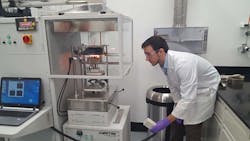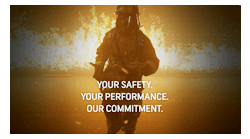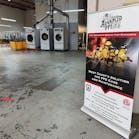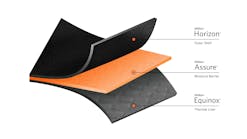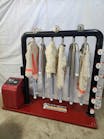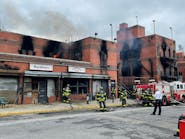The invention of Gore-Tex was essentially accidental.
“I was trying to make a cheaper plumber’s tape,” said Bob Gore, the son of W.L Gore & Associate’s founders Bill and Vieve Gore. “Plumber’s tape was a pretty cheap thing in the first place,” Bob Gore said, explaining that he was trying to stretch it 10 percent to make it more porous using less content.
The material he invented far surpassed his goal and became something far more important than plumber’s tape.
“I discovered under certain conditions with certain kinds of Teflon, you could stretch this 10,000 percent,” Gore said. “I didn’t believe it, so I didn’t tell anyone.” Gore’s comments were met with laughter from an audience of editors and reporters from around the world.
They were gathered for a dinner to celebrate the 40th anniversary of Gore-Tex, the material made from Bob Gore’s invention and to mark the unveiling of W.L. Gore’s world-class, state-of-the-art fabrics testing facility at the company’s largest manufacturing facility in the U.S. located in Elkton, MD. The company also has a facility in Newark, DE, where last night’s celebration was held.
Continuing with his anecdotal story, Gore said the day after he made the discovery of expanded polytetrafluoroethylene (ePTFE) he went back into the lab and replicated the experiment with the same results.
Discovery leads to big business
“What I discovered is you could stretch this material and it became porous, but it also became very strong,” Gore said. He said he made just a tiny piece of the material and there was no thought that it would become the genesis, the seminal material that would launch an enterprise with 10,000 employees worldwide in markets as divergent as outerwear for runners, to medical implant devices to materials used in structural firefighting gear. The privately held company boasts about $3 billion in annual sales.
“When people started thinking about this strong microporous material and what it could be made into, we filed a patent six months later,” Gore said. “That foresaw most of the things we do today. It was just a matter of how to do it.”
What W.L. Gore does is remarkable. Its breathable, waterproof fabrics have been to the Moon with the Apollo 11 mission. It has also been to the top of Mount Everest in protective apparel worn by intrepid climbers. It has been incorporated into products to treat congenital heart defects and 40 million medical devices implanted worldwide.
It’s even in shoes for little kids and big boots for firefighters and in the liners in turnout gear that helps keep them safe and dry. It’s on U.S. soldiers in combat helping them keep safe and dry as well.
“That’s the nature of innovation,” said Terri Kelly, the CEO of W.L. Gore & Associates at last night’s dinner. “You try a lot of things and they all don’t work out…. But that’s OK. You’re testing a lot of things and we continue to challenge ourselves.… If you make something big too soon, it’s not a failure, it’s a discovery! That’s the spirit of our culture and that’s the spirit of what we want to continue, to help thrive in terms of really allowing our associates to be creative. I am really proud that we have that set of values that allow us to do that.”
Those values were set back on Jan. 1, 1958, when Bill and Vieve Gore started a new business venture in the basement of their Delaware home. Bill was a former DuPont research chemist who wanted to do his own thing with PTFE and had new ideas for how to organize a company. A little more than 10 years later, Bob, a graduate of the University of Delaware, made his big discovery and the rest is history.
The company today is a long way from those humble beginnings, but Bob Gore, who recently retired as the enterprise’s chairman of the board, still values hard work and innovation.
“One of the things that I am trying to promote at Gore right now is to make sure we are doing things,” he said. “Not planning things, not talking about things, but actually doing things because you can learn so much more when you actually do stuff.”
New testing facility
And with the opening of the brand new, multi-million dollar testing facility at the Elkton plant, the associates can go out and do stuff and test it to make sure it’s ready to perform how the customers expect the product to perform.
The facility has an environmental chamber that recreates up to 95 percent of the environments on Earth, from the blazing sun and heat found in Death Valley to the Amazonian rainforest humidity. It can also produce winds from a gentle breeze to a roaring storm.
The facility also has a rain tower, an important feature for a product that guarantees to keep its users dry. The rain tower can replicate rainfall from a light drizzle to a downpour of up to three inches per hour. It can also inject wind speeds up to five miles per second to give the simulation of wind-driven rain.
The company also invested in a new heat and flame protection lab with a new Cone Calorimeter used to help Gore engineers measure heat-release characteristics from the fabrics used in finished garments.
Testing firefighter apparel
There’s also a stored energy tester to evaluate low-heat flux scenarios where firefighters could experience sweat burns from standing outside a fireground. It can also test fabrics for reduction of protection during flashovers.
The heat and flame protection lab also has a pyrolysis combustion flow calorimeter (PCFC) Micro Combustion Calorimeter (MCC) giving the company the ability to test heat release and fire-preventive char generation.
All this testing and equipment is used to help determine a core value repeated by Gore Associates every day, “fit for use.”
In her remarks last night, CEO Kelly said the company recently got a new chairman of the board of directors, Bret Snyder, and the company is updating its strategy, looking to do things better and innovate more.
“Some of the feedback I’ve gotten from the associates is ‘How can we recreate that compelling purpose of why we are here?’” Kelly said, noting the company, from its founding, has been focused on innovation. “We searched deeply into that and why we are here as an enterprise. We all rallied around kind of our aspiration of improving lives through advanced materials.
Kelly added that Gore associates are passionate about what they do in a diverse market worldwide and recognizing the importance of doing it well.
“What is the unifying thing that brings the organization together?” Kelly asked. “I would say that passion and focus on solving these complex challenges using and leveraging our materials and technology to do that.”
